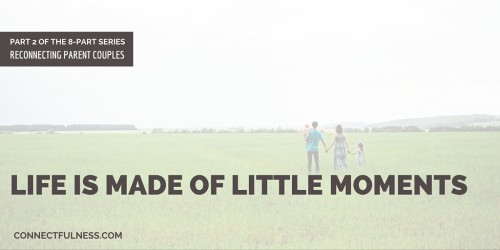A note on the Reconnecting Parent Couples Series: These eight posts present perspectives and advice from respected colleagues and experts from across the world. I’ll also weave in my personal and professional discoveries and introduce you to aspects of my evolving theory: Connectfulness.
>> Part 1: Redefining Intimacy After Children <<
Life swirls around us. The world becomes increasingly complex. And, in the midst of our busy days with their packed schedules and endless to-do lists, somehow the things that matter do get attended to: you eat, you sleep (some-nights better than others), you survive.
Surviving each day doesn’t mean you are thriving, however. And you don’t want to merely survive when it comes to what’s most important - your intimate relationships. You want to thrive.
In part 1 of this 8-part series, Redefining Intimacy After Children, we looked at how you change as a couple when you become parents, and I made you a promise that we’d dive deeper into how you can connect more fully.
Here’s a hint - it’s in the little moments.
Thriving is about developing and tending closeness and togetherness. It’s about bettering your understanding of yourself, your partner and your child(ren) and loving more fully. It's these very connections that I want to help you (re)focus on - this is what I’m striving to focus on in my own life too.
"Sometimes just cuddling together and talking is just the little moment you need to reconnect.” Mercedes Samudio, LCSW
You can tune into yourself, your partner, and also to your children through a practice of mindfulness It’s like this for just about everybody: so much of what we do in relationships we do without thinking. We act on autopilot programing that became part of our basic wiring in our own early childhoods. These primary experiences influence just about everything we do - especially how we handle intimacy in our adult relationships. Much of our programming might be positive, but the negative experiences can cause partners to feel lonely and disconnected in their marriage.
The first step, be mindful of the little moments.
In his book The Seven Principles for Making Marriage Work, John Gottman writes
“The first step in turning toward each other more is simply to be aware of how crucial these mini-moments are, not only to your marriage’s trust level but to it’s ongoing sense of romance. For many couples, just realizing that they shouldn’t take their everyday interactions for granted makes an enormous difference in their relationship. Remind yourself that being helpful to each other will do far more for the strength and passion of your marriage than a two-week Bahamas getaway.”
What Gottman's four decades of researching couples has brought to the field of relationship therapy is that these mini-moments are EVERYTHING when it comes to how a couple experiences one another and their relationship.
"I love the little moments. Grand gestures are nice too, but there is something so sweet and lovely about a small gesture that packs a whole lotta love! We may miss the little moment(s) our sweetie is offering as a way to connect because perhaps we are too busy or too tired, or we may be overlooking them because we think the moments should look a certain way, but I assure you they are happening. Each bid for attention is an opportunity to turn towards them and further connect or turn away and disconnect.I encourage you to start looking for these moments and accept them. The next time your partner asks you how your day was, share it with them. The next time your partner is jazzed about a new movie, offer to go see it with them. Intimacy and connection happens in the small moments, be sure to open your eyes and your heart to them." Dr. Lily A. Zehner
When you and your partner do turn towards one another every day, you create opportunities to fill one another up. When all else feels off, when your sense of self falters, your partner can be the secure base you can return back to over and over again. Ideally speaking, of course.
“Little moments are sitting back and seeing your mate parent the kids, slowing down and having gratitude for what the two of you have created” Anna Osborn, LMFT
On the other hand, when you repeatedly miss these moments, your relationship feels shaky. Missed moments of connection are akin to withdrawals, some larger and more taxing than others. So when you do connect in these special little moments, it's everything. Each of these moments - whether the connection is made and even when it’s missed - is an opportunity for you to see yourself as you really are and even heal your child-self. It’s an opportunity for you and your partner to find connection in one another and grow. In other words, every little moment can become an opportunity to help both of you feel more secure. As you relate to one another, learning to tune into and navigate one another’s insecurities, you can bolster and make life together feel safer and more connected.
“If partners realize that every time they see their partner smile, laugh or just enjoy themselves as a direct result of something they did or said was directly related to their OWN happiness, I think efforts would be doubled.” Robyn D’Angelo, MFT
Dr. Sue Johnson, founder of EFT (Emotionally Focused Therapy), explains how these patterns of disconnect can actually be a chance grow closer.
“Luckily, we all get stuck in the same places, so we can chart how lovers miss each other. We know that once you learn to SEE the moves, the dance, the pattern, and see how it plays out, you can chart a way out. The best way is to recognize the vulnerable emotions that shape each person’s steps.”
The things that matter most are the littlest moments our day that we forget to focus on.
“Physical touch is deeply connecting, in the most literal way. I encourage couples to touch each other, like a simple hand on a shoulder, pat on the tush in more playful moments, kiss on the cheek in passing. Adding touch to your interactions doesn't take much time and can elevate the mundane to something connecting and pleasurable. I'm also big on thank yous, you're welcomes, and I’m sorrys. We tend to grunt to each other, which is indicative of the depth of our closeness, but taking the effort to articulate appreciation and acknowledge the other person fully can go a long way.”Dr Jessica Michaelson
“The little moments add up to something big. Daily connection is making eye-contact, sharing an intimate smile, laughing together.“ Anita Mambo Cohn, LCSW, MA “
Almost every situation you and your partner find yourself in is an opportunity for connection. With or without children, chores around the house, dinner with the in-laws, or at school events—what the two of you know loud and clear is that both of you accept the responsibility of making every day count toward bringing you joy.” Stuart Fensterheim LCSW
I recently led a session on Connectfulness at the Mindful Mama Retreat in Pennsylvania where we talked about the importance of rituals of connection. One of the participants, Jennifer, wrote about her experience in her Mandalas for Mamas blog following the retreat, specifically of an exercise I sent participants home with, the six-second kiss. :
"And that’s exactly what I did when I got home that night – I chose my focus before I walked in the door (connection), I took a deep breath as I climbed over the obstacle course of toys, and I. kissed. my. husband. For six seconds. I gazed in his eyes. I saw his relief that I wasn’t starting off our hello with a complaint. It left me with a much better feeling than my usual approach."
Fantastic, isn't it?! You can read the whole post here- it is brilliant, Jennifer brought it home!
You need a six-second kiss
Let’s elaborate on this “exercise” Jennifer referenced: the six-second kiss. OK, so maybe it doesn't need too much elaboration, after all. It's, you guessed it, a kiss that lasts for a whole 6-seconds. Sounds simple enough, right? In theory yes, it is. But really, the intimacy that comes with literally being up in one another's faces for a whole 6-seconds. It can be intense. And hot!
When I introduce idea of the 6-second kiss I introduce along with it another exercise, 60-seconds of eye contact. I find gazing at one another is more do-able for couples who have histories of trauma or abuse simply because you don’t have to touch. Some find it easier, others more intense. All the couples I know that hop on board and practice it find themselves experiencing significant shifts.
Think of how you say good morning, good night, hello and goodbye to your life partner each day. Are these moments soft or harsh? Do you welcome a few seconds of intimacy or are you setting yourselves up for a missed moment? What impact would being mindful of these moments have on yourself, your relationship, and your life? These moments in the midst of the daily routine are the easiest to make into mindful rituals. Soften into these moments and see how you’re able to reconnect with one another more easily and more often.
>> PART 3 | Intimacy Begins With You: 7 Ways To Reconnect With Yourself (And The People You Love) <<
















 No wonder we struggle to connect to ourselves. No wonder intimacy and relationship satisfaction dwindles, especially after babies are born into families. No wonder we get frustrated with our children, lose our cool and then wonder why they don't listen to us. We've forgotten to play!
No wonder we struggle to connect to ourselves. No wonder intimacy and relationship satisfaction dwindles, especially after babies are born into families. No wonder we get frustrated with our children, lose our cool and then wonder why they don't listen to us. We've forgotten to play!



 Monday, December 16th, 2013, 6:00-8:00pm
Hosted by
Monday, December 16th, 2013, 6:00-8:00pm
Hosted by 


